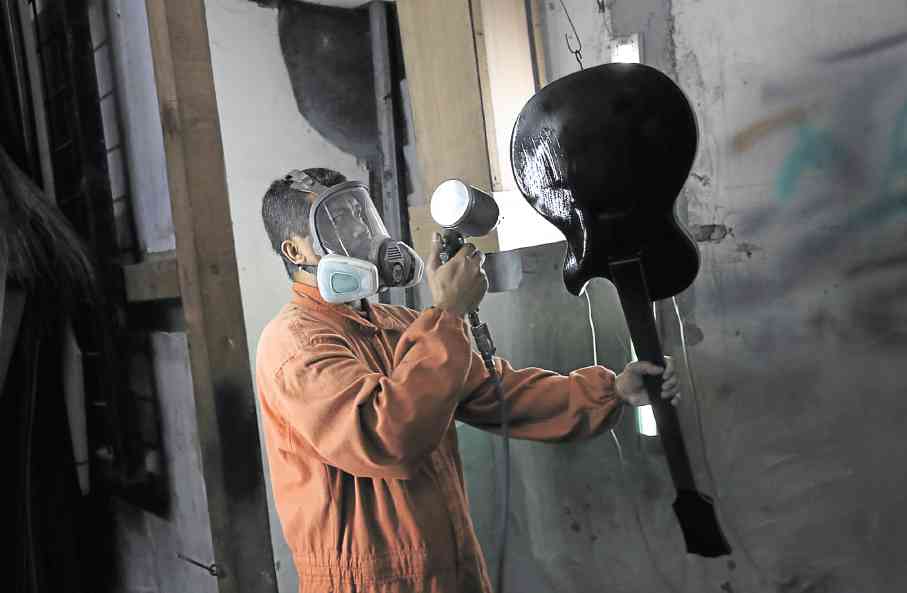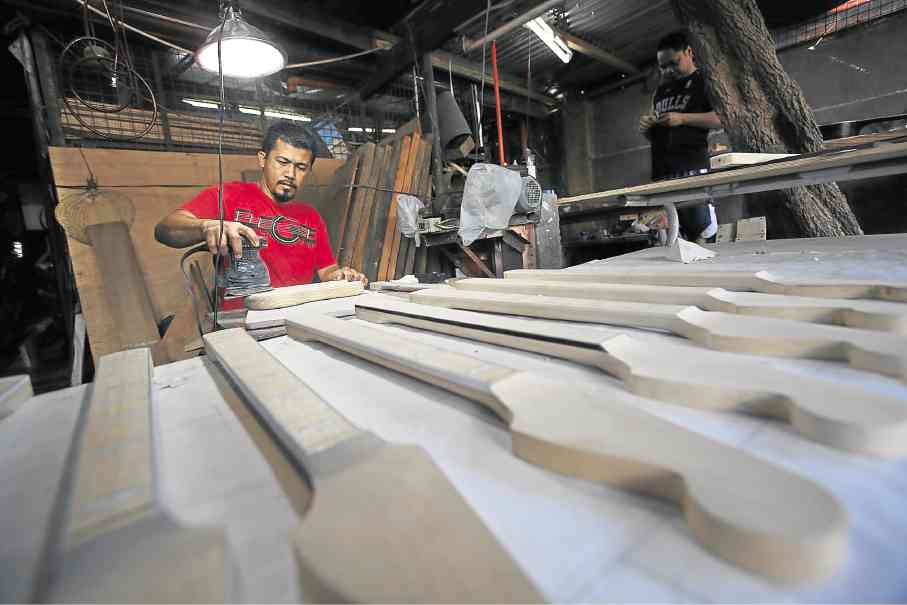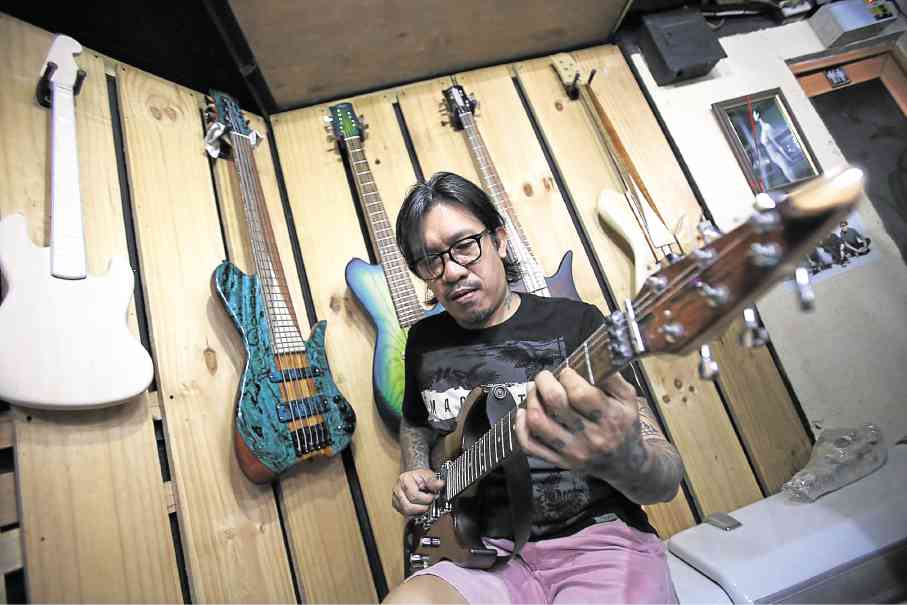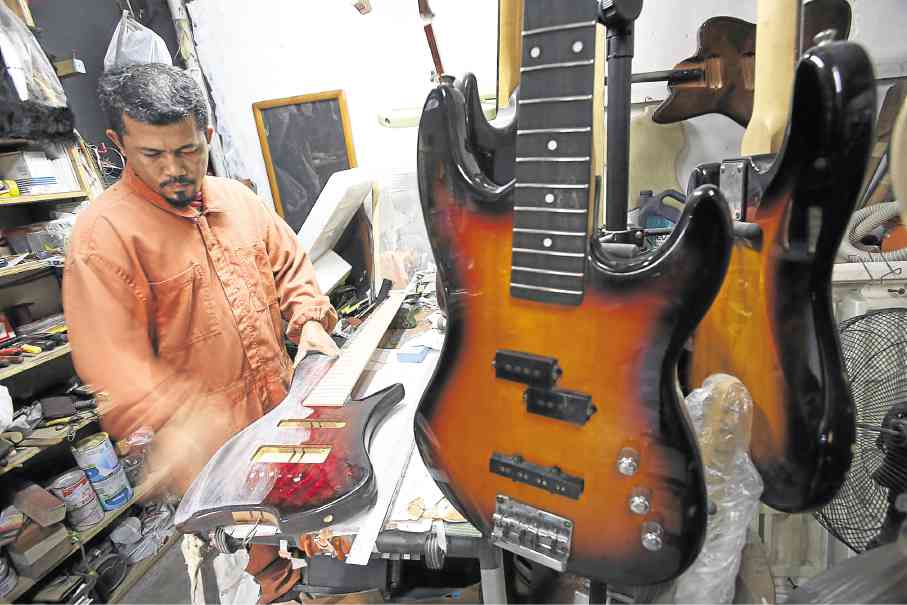Filipino luthier takes strings to US market
For 42-year-old Filipino luthier Jon Dela Cruz, breaking through the US market is no longer a pipe dream, but a challenging reality.
The tattooed Ilonggo musician who makes stringed instruments and runs the small Guitar 1 Elegee Custom Shop had just triumphantly showcased his electric bass guitar creations at the National Association of Music Merchants (NAMM) trade show held recently in California.
He had registered for the exhibit just for the experience in January, and thought that getting noticed was a long shot in the closely knit world of musicians attending America’s premier musical trade show aimed at strengthening the $17 billion global music products industry.
“I did not expect that our brand would make some waves; it was just luck that one musician tried our guitar and was impressed. He was surprised too that there are makers of original quality guitars in the Philippines,” Dela Cruz told the Inquirer.
The man, sessionist Roy Lambert, went around the exhibit area and told other musicians about his find. Soon, a crowd had lined up to try the guitars, which were handsomely designed with a Philippine flag on their fret boards.
The positive response was overwhelming, and two months since Dela Cruz and his staff returned home, inquiries about Manila’s guitar maker kept coming. Currently, Dela Cruz and his four-man staff are working on guitars ordered by Oskar Cartaya, a Los Angeles-based bass sessionist formerly of crossover jazz band Spyro Gyra.
“When we decided to go, we didn’t think we’d be noticed. We felt like underdogs. We didn’t have any money to hire known musicians to promote our designs, and we didn’t have calling cards,” Dela Cruz said.
“But [the foreign musicians] were surprised. They didn’t know that there were Filipino luthiers. Because of this exposure, we now have orders from five US-based musicians. The impact on our business is huge,” he said.
Nondescript shop
As a skilled luthier, Dela Cruz produces just a few bass guitars a month. Apparently, the only other Filipino to have a NAMM booth was Ramon Jacinto aka “RJ,” back in the 1980s. The aging rocker is still renowned for his RJ Guitars.
Dela Cruz’s nondescript shop is located in a row of apartments on a busy street in northern Manila’s Cubao district, just a few meters beside the imposing structure of a church and across what looks like a government safehouse of sorts.
Visitors wouldn’t know that guitars are manufactured there, but for the occasional buzz of an electric saw and the faint smell of paint and varnish.
At any given time workers are polishing, tuning and shaping boards for the guitars. A surf board hangs in a tiny office and photographs of Dela Cruz with various Filipino and American musicians are scattered around the chaotic shop.
Industrial tools—mostly those used for shaping and sawing—lie everywhere, while on a table are fret boards and other guitars in various stages of construction. On the walls are finished products, including those that were exhibited in California.
Dela Cruz tested a finished guitar, and played a familiar riff. His forehead was knotted in concentration while a smile played on his face.
“It’s free to dream,” the father of two said. “Maybe in five years, our guitars would be everywhere.”

A worker puts on the finishing touches to some of the guitars sold by the Guitar 1 Elegee Custom Shop
Beginnings
Dela Cruz was 16 when he got his first guitar. His parents didn’t want to give him money, so he sold his BMX bicycle to purchase a simple acoustic instrument.
Curious about what made the instrument play harmony, he dissected it and before long, was putting it back again. For somebody who had yet to have formal guitar lessons, Dela Cruz surprised his relatives by announcing he would build his own instrument.
“My grandmother was particularly angry because I sawed off her antique headboard using basic carpentry tools,” he said. “My family was curious but let me be because they thought I could not build one. I was only in high school and wasn’t a musician.”
But as the instrument began to take shape, his family helped out little by little. His father, a goldsmith by trade, made him frets from flattened nails. The guitar’s bridge was cobbled together using broken TV antenna parts, while his first nut was a plastic toothbrush handle.
His hobby soon became his passion, and he improved his craft.
He would later take up architecture in college, first at the University of San Agustin in Iloilo, before he moved to Manila where he finished the course at the Far Eastern University.
“Architecture was a blessing. I learned design and proper measurements which I incorporated into my guitar builds,” he said.
Playing at gigs later on, he said he would fix his own guitar as he slowly built his reputation. But it took other established musicians some time to entrust their expensive equipment to some unknown guitar novice.
Soon, however, his guitars and creations gained renown as top quality, sturdy builds.
“My first real customers were the musicians I played with in gigs,” he said. “Others who owned expensive P100,000-guitars didn’t want to trust me.”
His loyal following were among the best in the business, and his personal touch added to the entire package.
“Then, by word of mouth, my guitars’ reputation spread, first among my friends, professional musicians and sessionists,” he said.
Dela Cruz said he believes his originally conceptualized guitar designs could be considered at par with instruments made by established guitar makers, like production line brands Gibson and Fender for instance.
His flagship design for the international market incorporates the Philippine flag on the fret board, using individual wood parts with three stars and a sun.
The electronics are made by hand individually, as well as the pickups—the device used to convert the vibration of the strings into electrical signals. “I taught my wife to rewind the pickups. The electronic parts are also sourced locally from a local electronic audio shop,” he said.
Handcrafted
Orders come in regularly, but clients know that these are made to order and not “mass production guitars,” Dela Cruz said.
“We want it done slowly, with attention to details. It really is a handcrafted guitar,” he said. “It’s sort of like doing the process the old way again, to also induce creativity.”
Among Dela Cruz’s local clients are top Philippine sessionists, as well as established local bands, among them Shamrock and Parokya ni Edgar. He said there are many others whose names he couldn’t mention, but that they believe “in our own local designs.”
“With the age of the Internet, people know technical stuff. People expect us to be able to compete internationally,” he said. “I believe in the near future our guitars would be known internationally for their top quality.”



